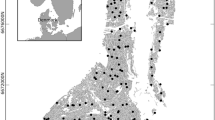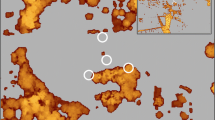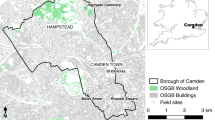Abstract
Airborne laser scanning provides continuous coverage mapping of forest canopy height and thereby is a powerful tool to scale-up above-ground biomass (AGB) estimates from stand to landscape. A critical first step is the selection of the plot variables which can be related to light detection and ranging (LiDAR) statistics. A universal approach was previously proposed which combines local and regional estimates of basal area (BA) and wood density with LiDAR-derived canopy height to map carbon at a regional scale (Asner et al. in Oecologia 168:1147–1160, 2012). Here we explore the contribution of stem diameter distribution, specific wood density and height-diameter (H–D) allometry to forest stand AGB and propose an alternative model. By applying the new model to a large tropical forest data set we show that an appropriate choice of input variables is essential to minimize prediction error of stand AGB which will propagate at larger scale. Stem number (N) and average stem cross-sectional area should be used instead of BA when scaling from tree to plot. Stand quadratic mean diameter above the census threshold diameter size should be preferred over stand mean diameter as it reduces the prediction error of stand AGB by a factor of ten. Wood density should be weighted by stem volume per species instead of BA. LiDAR-derived statistics should prove useful for estimating local H-D allometries as well as mapping N and the mean quadratic diameter above 10 cm at the landscape level. Prior stratification into forest types is likely to improve both estimation procedures significantly and is considered the foremost current challenge.



Similar content being viewed by others
References
Asner GP et al (2012) A universal airborne LiDAR approach for tropical forest carbon mapping. Oecologia 168:1147–1160
Chave J et al (2005) Tree allometry and improved estimation of carbon stocks and balance in tropical forests. Oecologia 145:87–99
Feldpausch TR et al (2011) Height-diameter allometry of tropical forest trees. Biogeosciences 8:1081–1106
Gourlet-Fleury S, Ferry B, Molino JF, Petronelli P, Schmitt L (2004) Experimental plots: key features. In: Gourlet-Fleury S, Guehl JM, Laroussinie O (eds) Ecology and management of a Neotropical rainforest. Lessons drawn from Paracou, a long-term experimental research site in French Guiana. Elsevier, Paris, pp 3–60
IPCC (2006) Guidelines for national greenhouse gas inventories. In: Eggelstons S, Buendia L, Miwa K, Todd N, Tanabe K (ed), vol. 4. Institute for Global Environmental Strategies (IGES), Hayama, Japan
Kennel P, Tramon M, Barbier N, Vincent G (2013) Canopy height model characteristics derived from airborne laser scanning and its effectiveness in discriminating various tropical moist forest types. Int J Remote Sens 34:8917–8935
Lim K, Treitz P, Wulder M, St-Onge B, Flood M (2003) LiDAR remote sensing of forest structure. Prog Phys Geog 27:88–106
Mascaro J, Detto M, Asner GP, Muller-Landau HC (2011) Evaluating uncertainty in mapping forest carbon with airborne LiDAR. Remote Sens Environ 115:3770–3774
Muller-Landau HC et al (2006) Comparing tropical forest tree size distributions with the predictions of metabolic ecology and equilibrium models. Ecol Lett 9:589–602
Temesgen H, Gadow K (2004) Generalized height–diameter models—an application for major tree species in complex stands of interior British Columbia. Eur J For Res 123:45–51
Vincent G, Weissenbacher E, Sabatier D, Blanc L, Proisy C, Couteron P (2010) Détection des variations de structure de peuplements en forêt dense tropicale humide par Lidar aéroporté (small foot-print airborne LiDAR proves highly sensitive to changes in structure of moist tropical forest). Rev Fr Photogramm Teledetect 191:42–50
Vincent G, Caron F, Sabatier D, Blanc L (2012a) LiDAR shows that higher forests have more slender trees. Bois For Trop 314:51–56
Vincent G et al (2012b) Accuracy of small footprint airborne LiDAR in its predictions of tropical moist forest stand structure. Remote Sens Environ 125:23–33
Acknowledgments
This work has benefited from an Investissements d’Avenir grant managed by the Agence Nationale de la Recherche (CEBA, ref. ANR-10-LABX-25-01).
Author information
Authors and Affiliations
Corresponding author
Additional information
Communicated by Gerardo Avalos.
Rights and permissions
About this article
Cite this article
Vincent, G., Sabatier, D. & Rutishauser, E. Revisiting a universal airborne light detection and ranging approach for tropical forest carbon mapping: scaling-up from tree to stand to landscape. Oecologia 175, 439–443 (2014). https://doi.org/10.1007/s00442-014-2913-y
Received:
Accepted:
Published:
Issue Date:
DOI: https://doi.org/10.1007/s00442-014-2913-y




